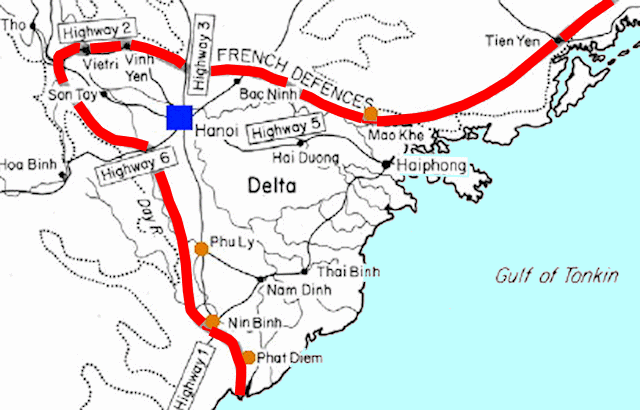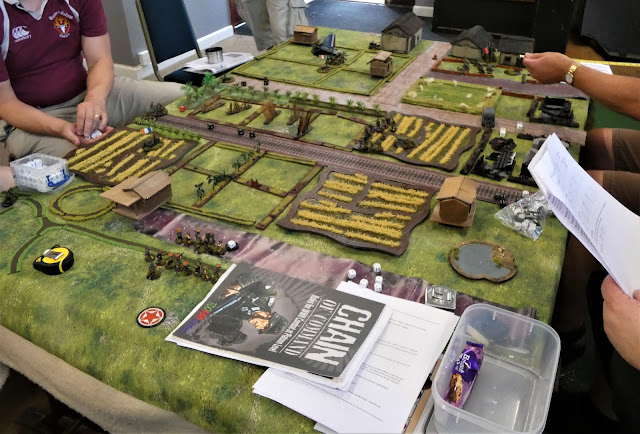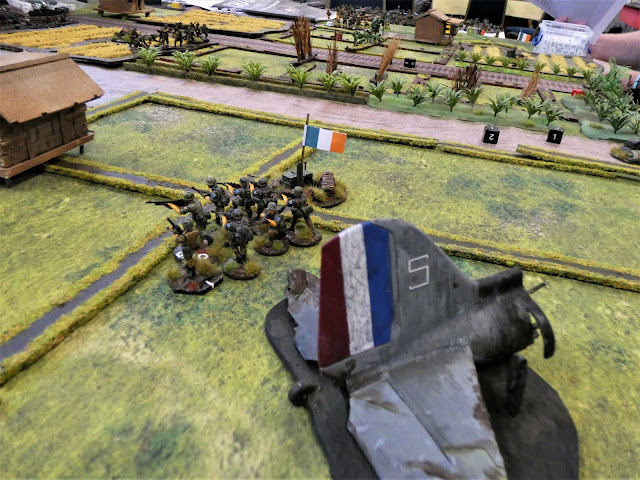By 1947 France had largely regained its Indo-China colony (today Vietnam, Cambodia, Laos), except for Ho Chi Minh’s hold-out in the mountainous jungles of northern Tonkin.
On 7th October 1948 French paratroopers descended and a pincer force encircled the Viet Minh (hereafter VM); but in this terrain pincers and encirclements were meaningless. The VM slipped away, mostly into China. The French built a string of border-forts but Hanoi was 300 kms away and the mountainous roads poor.
In China, Ho’s military lieutenant General Giap, built up the VM army from one of battalions to one of divisions. In October 1950 the French boarder-forts were over-run and the retreating French forces decimated; low morale and civilian panic stalked Hanoi. The Chinese had entered the Korean war so the USA was unlikely to rescue French Indo-China.
1951 was the year for the VM knock-out blow
 |
| The de Lattre Line under construction and the line around the delta area. Vinh Yen, Mao Khe, Nin Bihn and Phat Diem are shown on map. |
Paris now sent General de Lattre de Tassigny, a soldier in the highest French tradition, to Hanoi with combined military and civil powers.
In 1940 his division fought creditably and never lost its cohesion. Under Vichy command, he had been imprisoned for defying their orders, but escaped to join the Free French. As a senior allied commander in the liberation of Southern France and the advance into Germany, he had commanded both French and US units. De Lattre signed the formal surrender of German forces, alongside Eisenhower, Zhukov and Montgomery. And now de Lattre was in Hanoi, with an icy determination to restore France’s fortunes.
De Lattre ordered blockhouses and strong-points constructed to surround The Red River Delta, “The de Lattre line”, to protect the economic heartland of Tonkin. French male civilians were drafted for guard duties to release troops from garrison duties, the evacuation of the women and children was cancelled. But de Lattre could not stop the VM posters saying that Ho Chi Minh would be in Hanoi for the coming Tet festival (February 1951).
 |
| General de Lattre de Tassigny and his son Bernard. Bernard was killed near Ninh Binh on 30th May 1951. |
The VM did not disappoint. In January 1951, Giap attacked the north-western end of the de Lattre line, at Vinh Yen, aiming for Hanoi. French defences were overrun by VM human-wave assaults; mobile reinforcements were ambushed and destroyed. De Lattre flew into Vinh Yen to take personal command. More troops were flown in from the south and every aircraft capable of dropping ordinance was drafted in; the French managed to hold the line. Not deterred, in March Giap shifted his attack to the north-eastern end of the line near Mao Khe. Here an advance of 20km’s would threaten Hiaphong. Fortunately for the French, the river is deep here and naval forces moved upstream to break up VM attacks with concentrated firepower.
 |
| Graham Greene described Phat Diem cathedral as “more Buddhist than Christian” in his novel ”The Quiet American”. |
Giap now attacked for a third time. This time the VM switched to the southside of the delta, where it is bounded by the River Dai (Day). Giap planned to cross the river around the town of Ninh Binh and then swing south east to unhinge the French position from the south. French outposts here were not strong because the Catholic Bishop of Phat Diem was equally nationalistic and anti-communist; the bishop was determined to stay out of the war.
Giap concentrated his forces secretly and attacked the French on 29th May. Caught by surprise, initially only limited local reinforcements were available, but now more experienced, the French acted faster. Gunboats were sent upstream to sink the sampans and junks that were the VM’s life-line. Armoured mobile forces and paratroopers were sent south to counter the VM attack. French artillery and airstrikes were very effective as the VM manoeuvred in the open rice paddy terrain. Fighting was intense with outposts changing hands several times, but by the middle of June the VM’s position was untenable and Giap withdrew; it is these attacks that form the backdrop to our game today.
While the Red River Delta area had been held, the French would never successfully sustain a presence in Tonkin outside of the delta area again. The VM would consolidate their hold on Tonkin and expand their operations elsewhere in Vietnam and Laos with increasing confidence. General Giap would not attempt to take on the French directly again until 1953 at Dien Bin Phu, which is far away from The Red River delta. General de Lattre returned to France due to ill health and died the following year.
Order of Battle and rule modifications
French Union Forces
One platoon of 10th
Moroccan Paratroopers (two sections) – Elite (1 extra command dice 1 to 4 only)
One platoon of Vietnamese
infantry (three sections) – Regular
Mobile force with limited
organic infantry support – Regular
Off table support fire
Viet Minh
Two platoons of main force Viet Minh infantry (three
sections) – Regular,
One platoon of local and infiltrated Viet Minh troops (three
sections) - Green
Demolition team, 2 x bazooka teams.
Off table support fire.
Viet Minh troops are highly indoctrinated:
regulars add one to the force morale roll, green do not, minus two.
Chain of Command rules: per the main rule book set and the DMZ second tour supplement.
Off table Support Fire.
Both sides have off table support, at both the company and
regimental level. Company level support
weapons are deployed onto friendly jump off points, counting the JOP as the
point for line of site and range. If the
JOP is over run the support weapon is removed from play. These weapons include recoilless rifles,
mortars, MG’s etc. In addition,
off-table artillery strikes can be called in by the normal rule procedure, with
VM strikes counting as 50mm mortars and the French as 81mm mortars. The French
also have the option for airstrikes.
Terrain: the paddy fields count as heavy going for all movement. Only fully tracked vehicles can move in the paddy fields. Vehicles hit crossing dykes count as weakest lowest armour grade.
There were sufficient players today familiar with the rules, Chain of Command by The Two Fat Lardies and the Vietnam DMZ supplement by Jason Sendjirdjian of Car Port Games for them to play without much interference from me.
 |
| https://carportgaming.blogspot.com |
Jason’s supplements cover both the war in South Vietnam and the earlier French Indo-China war; there is other material of interest on Jason’s blog too.
The VM had two regular platoons of infantry and one green platoon of local troops; all VM troops are highly indoctrinated and have improved morale. The French has two infantry platoons, one of elite Moroccan paratroopers and one of local recruited regular Vietnamese and their Force Mobile column of vehicles, with its organic limited supporting infantry.
Both sides are attacking each other, as this is a no holds barred attempt to destroy your enemy and seize terrain – the prize is Indo China. The VM have a significant advantage in manpower but the French are supported by vehicles from their mobile column, while the VM have no vehicles.
The paddy field terrain is heavy going and impassable to wheeled vehicles and the field bunds make good defensive positions. The VM didn’t forget to bring along their anti-vehicle weapons too and they are in position of the now abandoned French strong point.
Both sides have off table weapons at the company and regimental artillery level. The French have access to airstrikes too.
With the patrol phase completed the main action began. The VM won the initiative but both sides seemed oddly cautious to start, just rolling command dice to build up chain of command points; perhaps it was the early morning mist or the mid-day heat.
The absence of people working in the paddy fields was a sure sign something was going to happen soon however. Cautiously the VM pushed out some local troops probing towards the French lines. Spotted by the French this unit was engaged by off table recoilless rocket fire, using high explosive rounds.
Soon more and more units of VM appeared crossing the paddy fields towards the French jump off points, to be met by counter deployments of French troops. The VM players clearly understood that their best option was to close in on the French and initiate close quarter combat.
A French JOP was threatened and the owning player had to use a Chain of Command point to redeploy it somewhere safer.
The French players brought their artillery observation teams on and soon called-in off table fire. The artillery strikes supporting the locally recruited Vietnamese troops proved to be particularly effective. But notwithstanding the VM pressed home their close quarter attack on a Vietnamese section; even though the VM squad was wiped out, they had caused sufficient casualties and shock for the Vietnamese unit to rout too.
Here the higher motivation of the VM was a
clear advantage as they were better able to absorb these types of setbacks;
soon the Vietnamese were suffering from declining morale.
By now the French Force Mobile had arrived deploying along the road and railway line – hoping to dominate the centre part of the battlefield with their machine guns. Unfortunately, a VM recoilless rifle team had got the range and a half track and armoured scout car were soon knocked out.
An M8 Scott motorised howitzer was deployed, but the junior leader was soon wounded by mortar fire, in the open topped turret; the M8 got off the road into the paddy field out of line site of that VM recoilless rifle and continued to engage the enemy, but with less efficiency.
The French continued to rely of their company level off table support fire in the centre – but it wasn’t really adequate as the VM pushed forward.
With the VM pressing forward everywhere, could the Moroccan paratroopers save the day? A smaller than usual unit for chain of command, the elite paratroopers have enormous fire power. The off-table artillery fire kept the VM at reasonable bay on the one flank while the Moroccans held the other, but still the VM pressed forward helped by a reasonable number of double phases – fortune favours the bold.
So important was the continued artillery fire that the Vietnamese player used another Chain of Command point to keep the fire going at the point in the game where it would normally cease. And the Force Mobile used their chain of command point to ambush advancing VM troops, wiping out a depleted VM section before it could close to close quarters.
Eventually the Vietnamese troops had had enough and their morale collapsed to a point where they could no longer participate in the action. Fortunately for the French the VM had received sufficient losses so that they were unable to exploit this success.
On the other flank the VM, despite the Moroccans’ fire power, were still able to close to close-quarters combat. There was a large disparity in the fight, but the VM still managed to force a draw, causing another immediate round of hand-to-hand combat, where the disparity was even greater, but despite the VM being destroyed casualties were inflicted on the Moroccans.
By now the French were getting the upper hand, but only centimetre by centimetre. Their firepower had succeeded in holding off the VM sufficiently that insufficient numbers could break through to “grab their belts to fight them”.
The delta would be held today, but what would tomorrow bring? Certainly no respite for the Moroccan paratroopers or the Force Mobile, who would be called in to plug another gap and be slowly worn down by the constant operations.
Thanks to Bob and Greg for being French, and Nathan and Steve M for being the VM. Miniatures mostly from Empress and Gringo 40, vehicles mostly Rubicon.
Historical background source mostly “Street Without
Joy”, by Bernard Fall.
Stephen Huntsman










No comments:
Post a Comment